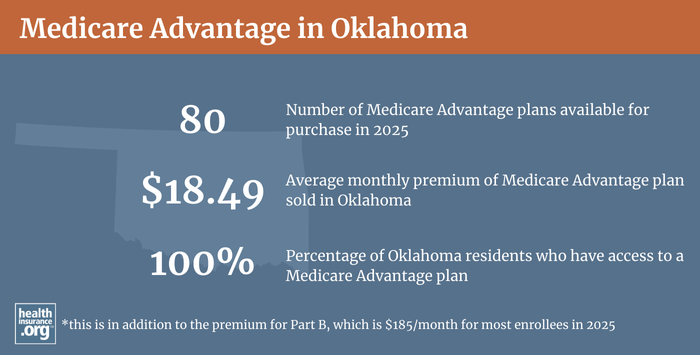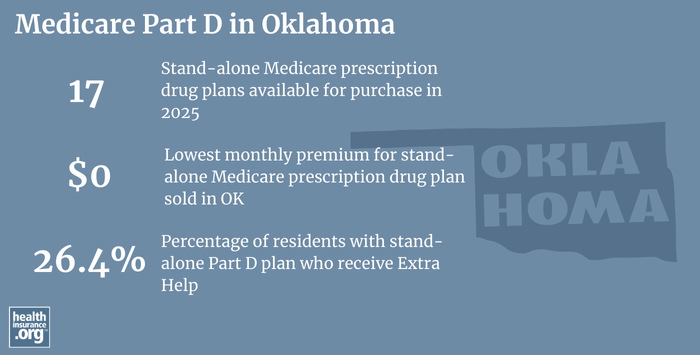Medicare in Oklahoma

Oklahoma was among the first states to ensure access to Medigap plans for people under age 65, and new rules allow continuous Medigap enrollees to switch to a plan with equal or lesser benefits
Key takeaways
- More than 800,000 Oklahoma residents are enrolled in Medicare.1
- 326,970 Oklahoma Medicare beneficiaries are enrolled in Medicare Advantage plans.1
- The availability of Medicare Advantage plans in Oklahoma ranges from two plans to 40 plans, depending on the county.2
- There are 17 stand-alone Medicare Part D prescription drug plans available in Oklahoma in 2025, with premiums that start at $0/month.3

Oklahoma Medicare enrollment
As of September 2024, there were 804,937 Oklahoma residents with Medicare coverage.1
In most cases, enrolling in Medicare goes along with turning 65, and people who are already receiving Social Security or Railroad Retirement benefits are automatically enrolled in Medicare when they turn 65.
But people also become eligible for Medicare if they have end-stage renal disease (ESRD) or amyotrophic lateral sclerosis (ALS), or after they’ve been receiving disability benefits for 24 months. As of late-2024, about 14% of Medicare beneficiaries in Oklahoma were eligible due to a disability rather than age.1 Nationwide, about 11% of all Medicare beneficiaries are under 65.4
Medicare options
In most areas of the country, Medicare beneficiaries can choose Original Medicare or a Medicare Advantage plan. Original Medicare is provided directly by the federal government and includes Medicare Parts A and Medicare Part B.
Original Medicare includes Part A (also called hospital insurance, which helps pay for inpatient stays, like at a hospital, skilled nursing facility, or hospice center) and Part B (also called medical insurance, which helps pay for outpatient care like a doctor appointment or a preventive healthcare service).
Under Medicare Advantage, private health insurance companies manage and administer the plans under contract with the federal government. Medicare Advantage plans include all of the benefits of Original Medicare, and they typically have additional benefits, such as coverage for prescription drugs (ie, Medicare Part D), dental, and vision.
But provider networks are often limited with Medicare Advantage, and out-of-pocket costs are typically higher than a person would have if they opted for Original Medicare plus a Medigap plan. In short, there are pros and cons either way, and no one-size-fits-all solution.
Learn about Medicare plan options in Oklahoma by contacting a licensed agent.



Explore our other comprehensive guides to coverage in Oklahoma

We’ve created this guide to help you understand the Oklahoma health insurance options available to you and your family, and to help you select the coverage that will best fit your needs and budget.


Hoping to improve your smile? Dental insurance may be a smart addition to your health coverage. Our guide explores dental coverage options in Oklahoma.


Learn about Oklahoma’s Medicaid expansion, the state’s Medicaid enrollment and Medicaid eligibility.


Short-term health plans provide temporary health insurance for consumers who may find themselves without comprehensive coverage. Learn more about short-term plan availability in Oklahoma.

Frequently asked questions about Medicare in Oklahoma
What is Medicare Advantage?
Over 19% of beneficiaries of Medicare in Oklahoma were enrolled in Medicare Advantage plans as of 2018,5 compared with an average of 34% nationwide.6 But by September 2024, enrollment in Medicare Advantage plans in Oklahoma had grown to 40% of the state’s total Medicare population,1 with 326,970 Oklahoma Medicare beneficiaries enrolled in Medicare Advantage plans. The other 477,967 enrollees had Original Medicare.1
For 2025, the availability of Medicare Advantage plans in Oklahoma ranges from just two plans in some rural counties, to 40 plans in some urban counties.2
The Medicare Annual Election Period (October 15 to December 7 each year) allows Medicare beneficiaries the chance to switch between Medicare Advantage and Original Medicare (and add, drop, or switch to a different Medicare Part D prescription drug plan). People who are already enrolled in Medicare Advantage plans also have the option to switch to a different Medicare Advantage plan or to Original Medicare during the Medicare Advantage Open Enrollment Period, which runs from January 1 to March 31.

What is Medigap?
More than half of Original Medicare beneficiaries have supplemental coverage under an employer-sponsored plan or Medicaid.7 But for those who don’t, Medigap plans (also known as Medicare supplement insurance plans) will pay some or all of the out-of-pocket costs that Medicare beneficiaries would otherwise have to pay themselves.8 Original Medicare does not limit out-of-pocket costs, so most enrollees maintain some form of supplemental coverage; Medigap plans are what’s available for people who don’t have access to an employer-sponsored plan (including retiree plans) or Medicaid.
Although Medigap plans are sold by private insurers, the plans are standardized under federal rules. There are ten different plan designs (differentiated by letters, A through N), and the benefits offered by a particular plan (Plan A, Plan F, etc.) are the same regardless of which insurer is selling the plan. So it’s easier to compare Medigap policies than it is to compare other types of health insurance; consumers can base their decision on premiums and less tangible factors like customer service, since the benefits themselves are uniform.
43 insurers offer Medigap plans in Oklahoma for 2025.9 And according to America’s Health Insurance Plans (AHIP) analysis, there were 191,347 Medicare beneficiaries in Oklahoma who had Medigap coverage as of late-2022.10
Unlike other Medicare coverage (Medicare Advantage plans and Medicare Part D prescription drug plans), there is no annual open enrollment window for Medigap plans.11 Instead, federal rules give enrollees a one-time six-month window when Medigap coverage is guaranteed-issue. This window starts when a person is at least 65 and enrolled in Medicare Part B (you must be enrolled in both Part A and Part B to buy a Medigap plan).
However, Oklahoma has created an opportunity for Medigap enrollees to switch to another Medigap plan with equal or lesser benefits, on a guaranteed-issue basis, as long as they haven’t had more than a 90-day gap in coverage since they first enrolled in Medigap. This opportunity became available in September 2023, and is not limited to certain times of the year. Several other states have also created opportunities for people to switch to a different Medigap plan (typically with equal or lesser benefits), but it is common to see them limited to a specific window each year.
People who aren’t yet 65 can enroll in Medicare if they’re disabled and have been receiving disability benefits for at least two years, and more than 110,000 Medicare beneficiaries in Oklahoma are under age 65.1 Federal rules do not guarantee access to Medigap plans for people who are under 65, but Oklahoma is among the majority of the states that have implemented rules to ensure that disabled Medicare beneficiaries have at least some access to Medigap plans.
Oklahoma was one of the first states to address this issue, and has guaranteed access to Medigap plans for people under age 65 since 1994. The initial rule just required Medigap insurers to offer at least one plan to applicants under the age of 65. But since 2017, state law has also required insurers to offer that policy without charging a higher premium to disabled enrollees (see OAC 365:10-5-129(d)). Medigap insurers in Oklahoma have to offer at least one Medigap plan to enrollees under the age of 65, during a six-month open enrollment period that begins when the person is enrolled in Medicare Part B. And insurers cannot charge a premium higher than the lowest available age-based premium that applies to that plan (ie, the rate that would be charged for a 65-year-old enrolling in the plan after gaining eligibility for Medicare due to age).
Almost all of Oklahoma’s Medigap insurers have opted to offer Plan A as their option for enrollees under the age of 65, and several companies offer Plan B, high-deductible Plan F, and high-deductible Plan G to enrollees under age 65.12
People who have Medicare prior to age 65 are granted a six-month Medigap Open Enrollment Period when they turn 65, during which they can select any available plan from any insurer in their state.11 Many more Medigap options are available to people who are turning 65 than to people below that age, so this is an opportunity for an enrollee to obtain more robust coverage if they prefer it (Plan A, which is the option that most insurers make available to people under age 65 who have Medicare in Oklahoma, is the least comprehensive Medigap plan). Oklahoma requires Medigap insurers to notify under-65 enrollees (prior to their 65th birthday) that their window to enroll in any plan on a guaranteed-issue basis is approaching.
Although the Affordable Care Act eliminated pre-existing condition exclusions in most of the private health insurance market, those rules don’t apply to Medigap plans. Medigap insurers can impose a pre-existing condition waiting period of up to six months, if you didn’t have at least six months of continuous coverage prior to your enrollment. And if you apply for a Medigap plan after your initial enrollment window closes (assuming you aren’t eligible for one of the limited guaranteed-issue rights or utilizing Oklahoma’s new rule that allows people with continuous Medigap coverage to switch to a plan with equal or lesser benefits), the insurer can consider your medical history in determining whether to accept your application, and at what premium.
What is Medicare Part D?
Original Medicare does not provide coverage for outpatient prescription drugs. More than half of Original Medicare beneficiaries have supplemental coverage via an employer-sponsored plan (from a current or former employer or spouse’s employer) or Medicaid, and these plans often include prescription drug coverage.7
But people who are enrolling in Medicare and do not have prescription drug coverage through Medicaid or an employer-sponsored plan may need to obtain Medicare Part D prescription drug coverage. Medicare Part D plans can be purchased as a stand-alone Medicare Part D prescription drug plan, or as part of a Medicare Advantage plan with integrated Part D coverage.
For 2025 coverage, there are 17 stand-alone Medicare Part D prescription drug plans in Oklahoma, with premiums that start at $0/month.3
As of September 2024, 301,493 Oklahoma Medicare beneficiaries had prescription drug coverage under stand-alone Medicare Part D prescription drug (PDP) plan enrollment.1 Another 300,289 Oklahoma Medicare beneficiaries had Medicare Part D prescription drug coverage integrated with their Medicare Advantage Prescription Drug (MAPD) plans.1 Medicare Advantage enrollment has been increasing at a much faster pace than overall Medicare enrollment, so the number of beneficiaries with MAPD coverage has been steadily growing, while the number of people with stand-alone PDP coverage has been declining.
Medicare Part D prescription drug plan enrollment is available when a person is first eligible for Medicare, and there is also the Medicare Annual Enrollment Period in the fall, from October 15 to December 7, when beneficiaries can enroll in a Medicare Part D prescription drug plan or switch to a different prescription drug plan for the coming year.

How does Medicaid provide financial assistance to Medicare beneficiaries in Oklahoma?
Many Medicare beneficiaries receive financial assistance through Medicaid with the cost of Medicare premiums and services Medicare doesn’t cover – such as long-term care.
Our guide to financial assistance for Medicare enrollees in Oklahoma includes overviews of these benefits, including Medicare Savings Programs, long-term care coverage, and eligibility guidelines for assistance.
What additional resources are available for Medicare beneficiaries and their caregivers in Oklahoma?
Questions about Medicare eligibility in Oklahoma or Medicare enrollment in Oklahoma?
- Visit the website for the Oklahoma Senior Health Insurance Counseling Program with questions related to Medicare coverage in Oklahoma. If you prefer to call, the number is 1-800-763-2828.
- The Oklahoma Insurance Department maintains a page of resources for people who are eligible for Medicare in Oklahoma.
- Visit the Medicare Rights Center website or call 1-800-333-4114. This nationwide resource provides helpful information geared to Medicare beneficiaries, caregivers, and professionals.
Louise Norris is an individual health insurance broker who has been writing about health insurance and health reform since 2006. She has written dozens of opinions and educational pieces about the Affordable Care Act for healthinsurance.org.

Looking for more information about other options in your state?
Need help navigating health insurance options in Oklahoma?
Explore more resources for options in Oklahoma including ACA coverage, short-term health insurance, dental insurance and Medicaid.
Speak to a sales agent at a licensed insurance agency.
Footnotes
- “Medicare Monthly Enrollment – Oklahoma.” Centers for Medicare & Medicaid Services Data. Accessed January, 2025. ⤶ ⤶ ⤶ ⤶ ⤶ ⤶ ⤶ ⤶ ⤶
- ”Medicare Advantage 2025 Spotlight: First Look” KFF.org Nov. 15, 2024 ⤶ ⤶
- ”Fact Sheet: Medicare Open Enrollment for 2025” (110) Centers for Medicare & Medicaid Services. Sep. 27, 2024 ⤶ ⤶
- “Medicare Monthly Enrollment – US” Centers for Medicare & Medicaid Services Data. Accessed January, 2025. ⤶
- Medicare Monthly Enrollment – Oklahoma (2018).” Centers for Medicare & Medicaid Services Data, May 2018. ⤶
- Monthly Medicare Enrollment – US (2018).” Centers for Medicare & Medicaid Services Data, May 2018. ⤶
- Ochieng, Nancy, Gabrielle Clerveau, and Tricia Neuman. “A Snapshot of Sources of Coverage among Medicare Beneficiaries.” Kaiser Family Foundation, September 23, 2024. ⤶ ⤶
- “Get Medigap Basics.” Medicare.gov. Accessed September 30, 2023. ⤶
- “Explore your Medicare coverage options.” Medicare.gov. Accessed October, 2024. ⤶
- ”The State of Medicare Supplement Coverage” AHIP. May 2024 ⤶
- “Get Medigap Basics.” Medicare.gov. Accessed January, 2025. ⤶ ⤶
- “Supplement Insurance (Medigap) Plans in Oklahoma.” Medicare.gov. Accessed September 23, 2023. ⤶

